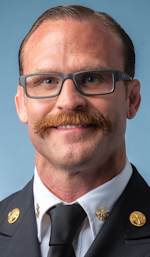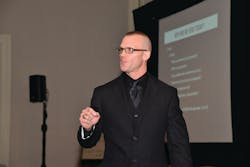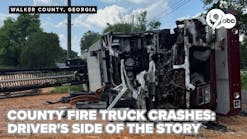Guest Commentary: "We've Always Done it This Way," But That Doesn't Mean It's Right
Editor’s note: David Griffin was the driver of the first engine to respond to a furniture warehouse fire that claimed the lives of nine of his fellow firefighters in Charleston, SC, in 2007. Since then, he has dedicated his life to ensuring that the tragedy never repeats itself. He will deliver the keynote address at Firehouse Expo 2014.
According to scholar Daniel Kim, “All organizations learn, whether they consciously choose to or not – it is a fundamental requirement for their sustained existence” (“The Link Between Individual and Organizational Learning,” Sloan Management Review, 1993). But what if this learning is outdated and follows the old adage “this is how we’ve always done it”? What they are saying is whether they consciously choose to or not, they continue to learn better ways to perform incorrectly. Congratulations in your effort to operate how you’ve always done it. Newsflash: THAT DOES NOT MEAN IT’S RIGHT. Unfortunately, this is all too common in our profession. How do we fix this problem in the fire service? Often, the answer comes too late, costing firefighters their lives.
An example of this was in Charleston, SC, on June 18, 2007, where nine firefighters perished in a furniture warehouse fire. I was the operator on the first-due engine on that tragic day. Nine of my friends perished due to the attitude of operating the same as we always had. In the seven years since this deadly incident, not only has the Charleston Fire Department (CFD) changed its belief of the way we’ve always done it, but so have numerous organizations around the world. The scary part is, there are still many out there that have not. If you haven’t, it’s time to wake up, make a change or find the closest exit because we don’t need you. You are a danger to everyone in this profession.
subhead
For those of you who have embraced change, but keep running into road blocks, there are eight steps you can take, according to Dr. John Kotter (Leading Change, Harvard Business Review Press, 2012). Not only have these eight steps worked in numerous organizations around the world, but they have changed a highly traditional fire department into a national model for progress and innovation.
It’s easy to talk about and find information regarding change, but what does change actually look like in our profession? Let’s examine an organization, the CFD, which used Kotter’s eight-step method as well as organizational learning to create sustained changed. I was and I still am a part of the change process in the CFD along with the great members of my organization. We have lived change since our nine friends lost their lives on June 18, 2007.
Before we highlight the changes within the CFD, let’s outline Kotter’s eight-step model:
1. Create urgency for change
2. Form a powerful coalition
3. Create a vision for change
4. Communicate the vision
5. Remove obstacles
6. Create short-term wins
7. Build on the change
8. Anchor the changes in corporate culture
After June 18, 2007, the members of the CFD needed direction. We were experiencing a leadership change after embarking on a national search for a new fire chief. Fortunately for us, we hired Chief Thomas Carr from Montgomery County, MD. From the day he arrived, he created a sense of urgency for change. He visited stations citywide to ascertain what the firefighters envisioned during the change process. This helped him not only identify areas that needed improvement, but also outliers in the organization. The open discussions also allowed him to request support from the members and let the members drive the changes.
Next, he formed a powerful coalition with individuals at all ranks. This is not to say that a coalition against him did not form, because it did, in a major way. (Unfortunately, due to my own ignorance, I was in the latter coalition.) He identified leaders across all levels of the organization who could help him institute change. As Assistant Chief Mark Davis said in the National Fallen Firefighters Foundation (NFFF) video “Charleston 9: The Ultimate Sacrifice,” “It’s the first time in my career out of 19 years and three fire departments that I have ever had a man just allow me to take my dreams and run with them.”
Committees were formed throughout the organization to allow the “guys with the boots on the ground the feeling of making an important decision for the direction of the department,” as I wrote in my 2013 book In Honor of The Charleston 9: A Study of Change Following Tragedy. We were witnessing simple empowerment at its best.
While all of the aforementioned was working in the background, Chief Carr created a vision for change, the third step in Kotter’s model. His office had easel pad paper all over the walls with different visions regarding operations, new equipment, pay plans, training, promotional processes, hiring, etc. He determined the values that were important for the change movement, developed bullet points for that change, created a strategy to execute the vision and spoke about the vision daily. When he spoke about the change, it was with such passion that others had no choice but to want to be a part of it.
Kotter’s fourth step, communicate the vision, was an everyday occurrence for Chief Carr. He didn’t just call meetings to speak about his ideas for change, he spoke about them everywhere he went, with firefighters, city government and citizens. His message was contagious. He addressed people’s concerns, as Kotter expressed must be done in this step, and applied his vision to all aspects of department operations. Was he still facing resistance? Of course, but the resisters were getting fewer by the day.
Next, Chief Carr removed obstacles to change by identifying change leaders whose main roles were to deliver the change to the troops, scrutinizing the organizational structure, examining the performance of the organizational members and identifying the areas of the compensation system that inhibited his vision to come to fruition. More importantly, he identified the people who were resisting the change and helped them see what was needed. Actions were then taken by the new team to remove any barriers. Change was now in full force.
During this time, Chief Carr created short-term wins to ensure the members recognized that we were making positive strides toward instituting a new organizational culture. He then formed a Strategic Planning Committee and let members of the department develop these short-term goals that would pave the path for the organization over the next decade. Empowerment at its best.
subhead
Step 7 of Kotter’s model states that we must build on the change. Furthermore, history indicates that the change process fails many times because we declare victory too quickly rather than continually improving. As we instituted more and more changes, we were becoming a new organization. We were trained to national standards and had new innovative apparatus, better equipment, a staffing increase, increased hiring standards, higher promotional standards, an innovative response package, incident command training, new uniforms, new leadership, on and on and on.
Kotter’s final step used by Chief Carr was to anchor the changes in the organizational culture. Research shows that to do this, organizational members must talk about progress every chance they get and speak of the successes of the change process. Furthermore, when new members are hired they must be educated on the change culture of the organization and how much work has gone into designing it. If this is not done, new members will not understand what has transpired before their arrival. If older members state “this is how we’ve always done it,” the changes are not anchored and more work must be done. If the members truly understand change and the process, this statement will be removed from their speech altogether. Will it be hard? Yes it will, but it can be expunged if we keep working.
During this time, we noticed a change in Chief Carr. He was becoming weaker and his voice was changing. We had a bad feeling that he was facing a serious illness, but we did not know for sure. Our suspicions were correct, and not long after, Chief Carr was diagnosed with a rare form of Parkinson’s disease, MSA. We were all saddened by this, but he did not let us dwell. Did this weaken his body? Yes. Did it weaken his mind? Hell no. That man marched on every day no matter how hard it was for him. He walked slower, spoke slower and became frail. However, he was still coming to work daily to institute change. His strength and dedication were unbelievable.
When there were times that WE wanted to quit the change process and go back to what we had always done, we thought of Chief Carr’s struggle just to perform simple tasks. He didn’t quit and we weren’t going to either. Deputy Chiefs John Tippett and Deputy Chief Frank Finley took turns helping him get to work because Chief Carr was going to fight until his last breath for change in this department. And fight he did. Do you think in his weakened state he was using the phrase, “this is how I’ve always done it?” No he wasn’t. He couldn’t do things the way he had always done. A disease took that away from him. He embraced where he was in his life and knew that the daily change in his body was a constant until he could no longer march on, and retired on March 2, 2012. He continued to fight for over a year, losing the battle to MSA on April 24, 2013. His life ended with thousands of lives changed forever.
Over the years Chief Carr was our leader, he had heard the same statement time and time again: “That’s how we’ve always done it.” He took that statement and destroyed it in every manner possible. We no longer do it the way we’ve always done it because we understand the changes in our operational environment. Some say that we’ve lost our aggressiveness and toughness due to this. I laugh and always think back to Chief Carr when he could barely walk or talk, but still came to work. He was as tough and aggressive as they come. But he was also SMART and used his mind to be effective.
When I was hired, I was told that I was hired from the “neck down.” I believed this until I was forced not to on June 18, 2007. I also believed the saying “that’s the way we’ve always done it” to be true. Well, both of those statements cost not only my nine friends their lives, but numerous firefighters their lives every year. If you still believe in these statements, you are sadly mistaken. We are THINKING firefighters who can still be aggressive with how WE DO IT NOW, not how we used to do it. In this profession, we think and make educated decisions based on science, not on “how we’ve always done it.” We have Chief Thomas Carr to thank for this. Rest in peace, Chief. We will never forget you and your dedication.
DR. DAVID GRIFFIN, CPSE, is a training instructor and hazardous materials technician for the Charleston, SC, Fire Department and the owner of On A Mission LLC, which offers speaking and instructing services for public, private and non-profit organizations. He holds a bachelor of science degree in education, a master of science degree in executive fire service leadership and a doctorate of education in organizational leadership and development. Griffin is a certified fire officer through the Center for Public Safety Excellence (CPSE) and is enrolled in the Executive Fire Officer Program at the National Fire Academy. He is the author of the book In Honor of the Charleston 9: A Study of Change Following Tragedy and may be contacted at www.drdavidgriffin.com.

Dr. David Griffin
Dr. David Griffin is the assistant chief of administration in Charleston, SC. He was the operator of the first-due engine on June 18, 2007, when nine of his fellow firefighters perished. Griffin has come through the ranks in operations in every uniformed position, from firefighter to battalion chief and shift commander to his current position, during his 20-year career in Charleston. He has a bachelor's degree in education from The Citadel, a master's degree in executive fire service leadership, and a doctorate of education in organizational leadership and development. Griffin is the author of "In Honor of The Charleston 9: A Study of Change Following Tragedy," among three other books. He is an international speaker and instructor, a certified Chief Fire Officer and Chief Training Officer with The Center for Public Safety Excellence, an IFSAC/Pro Board-certified Fire Officer IV and a graduate of the Executive Fire Officer Program from the National Fire Academy. He is a graduate of Harvard University's Kennedy School of Executive Education program: Senior Executives in State and Local Government and of the Psychology of Leadership program at Cornell University's SC Johnson College of Business. Griffin is the owner of On A Mission, LLC, at drdavidgriffin.com.






